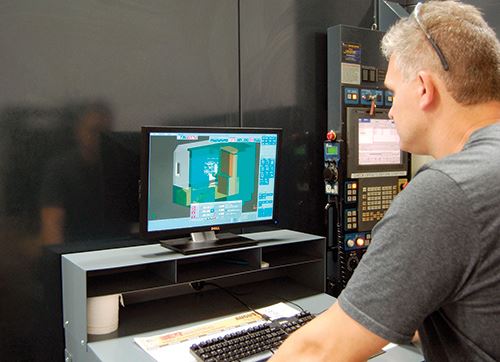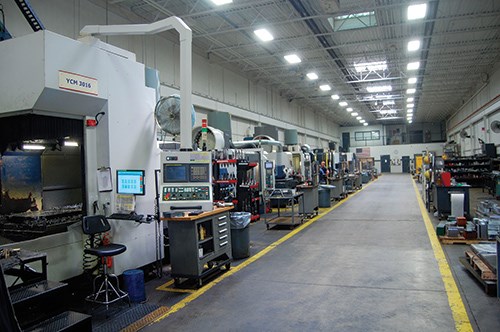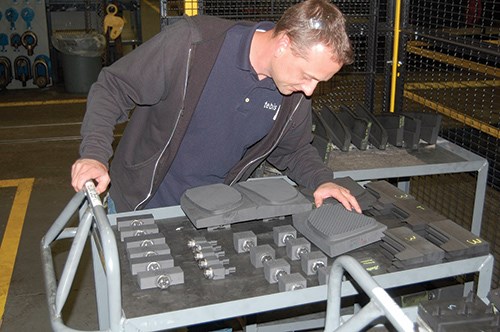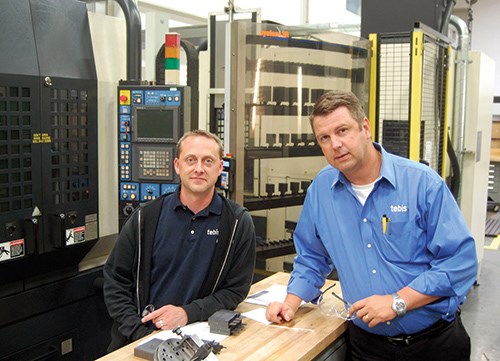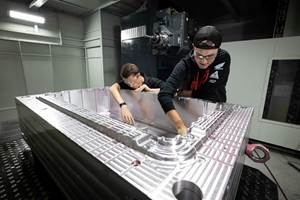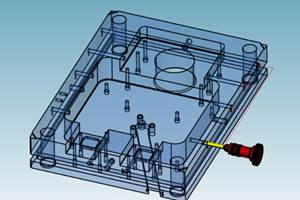CAD/CAM Upgrades Speed, Simplify Tool Build
A surfacing module and NC template technology are among the software features that help this mold manufacturer unleash the full potential of its equipment and its staff.
The larger the operation, the greater the need to automate repetitive processes and better coordinate work among individual departments. That's been the experience of Hi-Tech Mold & Engineering, a company that’s grown from a small shop with just a few employees to a full-service plastics industry supplier with a global footprint.
Although meeting these goals requires directing a critical eye inward, company personnel say feedback from outside partners has also proven invaluable. In one recent example, CAD/CAM software supplier Tebis helped identify opportunities for new efficiencies at multiple stages of the design and manufacturing process, from preparing surfaces and programming toolpaths to avoiding collisions and ensuring efficient setups. According to Hi-Tech, the result has been improved quality, faster throughput, and greater ability to realize the full potential of employees and equipment alike.
A Partner in Growth
Hi-Tech Mold & Engineering has come a long way since 1982, when Siegfried “Siggy” Schulte founded the family-owned business with just four people in Michigan’s automotive heartland. Today, the company's worldwide staff numbers 450. Its headquarters have moved from Fraser to Rochester Hills, Michigan, and it operates a second facility in Winchester, Tennessee. Its plastics industry customers hail from around the globe, from the U.S. and Mexico to Brazil to Germany. Its portfolio of services includes concept development and design, manufacture and repair of tools, fixtures and measuring systems. Schulte is now company chairman, and his son, Robert, is CEO.
Hi-Tech's collaboration with Tebis began in 2001 with the installation of a single CAD/CAM workstation after benchmark tests against other products. The number of CAD/CAM stations quickly rose from there, and the company also uses various other modules from the Tebis family of products, such as organizers, simulators and electrode manufacturing. Today, the software is utilized end-to-end in mold manufacturing, from job preparation to finished part.
Given Hi-Tech’s focus on product design, Tebis’ capability for smooth surface finishes wasn’t the only important factor in the company’s choice of software. CAD functionality played a role as well, says Kevin Taverner, vice president of operations. “The data exchange with Catia works smoothly,” he explains. “Data redundancy is reduced to a minimum, and all necessary specifications are retained. And geometries can be quickly adapted after import, thanks to the integrated CAD functionalities.”
The relationship between the two companies goes beyond Hi-Tech’s use of Tebis software. They also work cooperatively to improve moldmaking processes. In late 2011, a close analysis of Hi-Tech’s operation crystallized two opportunities for new efficiencies. First, using modules from the supplier’s boundary representation (BREP) product family during job preparation could speed downstream machining. Second, NC libraries and template technology could help streamline programming and help the company make use of its full potential.
Unleashed Potential
One particular BREP module, the Tebis Surfacer, is now considered an essential element of the machining process at Hi-Tech. The module enables combining any number of surfaces to reduce the overall number of segments. According to the supplier, this helps optimize the entire surface. During trials at Hi-Tech, the company found that the module could shorten milling processes by an average of 20 percent, a result that’s since been replicated on the shop floor.
In 2012, shortly after implementing the surfacing module, the company expanded departments handling deep boring and electrode machining. This proved an ideal time to implement improvements identified during the second part of the process analysis—improvements geared toward what is essentially NC automation. “By using NC templates including feature recognition and machine-specific tool libraries, we achieve a significantly higher quality with shorter throughput times,” says Tim Cheyne, application specialist. “We achieve faster and better results with fewer personnel.”
The Tebis Simulator has also become firmly established in the process chain. “All components, including the machine, tools and all retracts, are taken into account,” Cheyne explains, adding that the company’s use of simulation extends beyond collision avoidance. “We also use the Simulator as a planning tool for configuring the workpiece fixture and positioning. Thus, we can machine every component with the smallest possible machine.”
Cheyne adds that the time and cost savings resulting from the software upgrade also have ripple effects. For instance, using template technology to automate previously manual tasks frees the company to focus on more value-added activities. “Thanks to the template technology, even new employees without programming experience are able to create simple NC programs after only one week of training,” he says. “We harness the unleashed potential to develop new ideas, to refine processes and to advance our employees.”
Related Content
Hybrid Milling/Drilling Machine Reduces Total Mold Machining Time
MSI Mold Builders now squares, plus drills and taps eye-bolt holes on 50% of its tools in a single setup using a five-axis milling/drilling center with a universal spindle.
Read MoreFive-Axis Vertical Mill Increases Mold Shop Capacity by Reducing Setups
Zero Tolerance now processes blocks — from squaring to waterline drilling to rough and finish milling — on a single five-axis CNC mill, reducing setups and moving blocks in/out of multiple machines without sacrificing accuracy and surface finish.
Read MoreIntegrated CAD/CAM Streamlines Electrode Manufacture, Improves Quality
A focus on electrode design and automation helps toolroom improve efficiency, reduce tooling costs and deliver higher quality products.
Read MoreCAM Automation Increases Mold Production, Quality
Mold builder switches CAM software package after 20 years to take advantage of innovative programming strategies that reduce mold machining programming and processing times.
Read MoreRead Next
Are You a Moldmaker Considering 3D Printing? Consider the 3D Printing Workshop at NPE2024
Presentations will cover 3D printing for mold tooling, material innovation, product development, bridge production and full-scale, high-volume additive manufacturing.
Read MoreHow to Use Continuing Education to Remain Competitive in Moldmaking
Continued training helps moldmakers make tooling decisions and properly use the latest cutting tool to efficiently machine high-quality molds.
Read MoreReasons to Use Fiber Lasers for Mold Cleaning
Fiber lasers offer a simplicity, speed, control and portability, minimizing mold cleaning risks.
Read More
